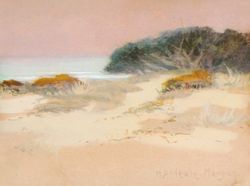|
Mary DeNeale Morgan
(1868-1948)
 | | click image to enlarge |
Mary deNeale Morgan was born in San Francisco, California on May 24, 1868. She was the second child of 7 children. She exhibited a talent for drawing at a young age and in 1886, enrolled at the School of Design. Although she originally studied under artist Virgil William, she was most influenced by artists Emil Carlsen, Amédée Joullin, and William Keith. She was a favorite pupil of William Keith from her youth until the time of his death.
In 1896, she opened a studio in Oakland and, for a brief time, taught art at Oakland High School. After the earthquake and fire of 1906, Morgan toured the city recording the destruction with crayons and pastels. She held her first solo exhibition at Oakland’s Hahn Gallery in 1907 with much success. Her works were typically signed M. deNeale Morgan, a fact that tended to conceal her gender from patrons and critics. She then moved to Carmel where she bought the studio-home of Sydney Yard located on Lincoln near Seventh. In 1914, she was a pupil in William M. Chase’s summer classes in Carmel. In 1917 she became the director of the Carmel School of Art and was also active in the Carmel Club of Arts and Crafts.
In 1922, Morgan’s successful career continued with a solo exhibition of 60 works consisting of 41 paintings and 19 monotypes at the Van Bosckerck Studio in Greenwich Village, New York City. This would be the first of many exhibitions that would be outside San Francisco. In 1927, Morgan was instrumental in the founding of the Carmel Art Association. During World War II she made weekly visits to nearby Fort Ord to sketch the servicemen. In 1944, Morgan received a solo show at the Carmel Art Association and was hailed as a Californian pioneer artist. Morgan died in Carmel on October 10, 1948 having left a great legacy to California art as a teacher, organizer, and painter.
After her death, her sister Jennie Klenke continued to maintain her studio. Working in pastel, oil, tempera, and watercolor, she painted sand dunes, adobes, landscapes, and the wind-swept cypresses of the Monterey Peninsula.
Member: National Association of Women Painter’s and Sculptors; San Francisco Art Association; California Watercolor Society; Laguna Beach Art Association; American Federation of Arts; Carmel Art Association; Carmel Arts & Crafts Club, West Coast Arts, Artists Guild, Chicago.
Exhibited: Oakland Industrial Expo, Oakland, California, 1896; Mark Hopkins Institute, California, 1897-98; Hahn Gallery, Oakland, California, 1907; Del Monte Art Galley, California, 1907-12, 1934; Berkeley Art Association, California, 1908; Alaska-Yukon Expo, Seattle, Washington, 1909; Panama-Pacific International Exposition, California, 1915; Hotel Oakland, California, 1925 (solo); Pasadena Art Institute, California, 1929; Carmel Art Association, California, 1934; Pennsylvania Academy of Fine Arts; Rochester Art Club, New York.
Works held: California Historical Society; Monterey Peninsula Museum of Art, California; Los Angeles County Museum of Art; Del Monte Hotel, California; University of Texas; Stanford University; University of Southern California; Union High School, Monterey, California; Monterey City Hall and Presidio, California; Sunset School, Carmel, California; Salinas High School, California, Society of California Pioneers.
Source:
Hughes, Edan M. Artists In California 1786-1940. 3rd ed. Vol. 1. Sacramento: Crocker, Art Museum, 2002. N. pag. 2 vols. Print.
Westphal, Ruth. Plein Air Painters of California: The North
|
|
|
|
|

